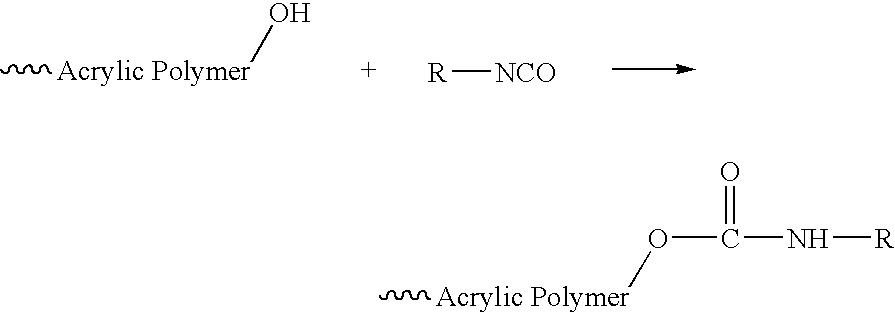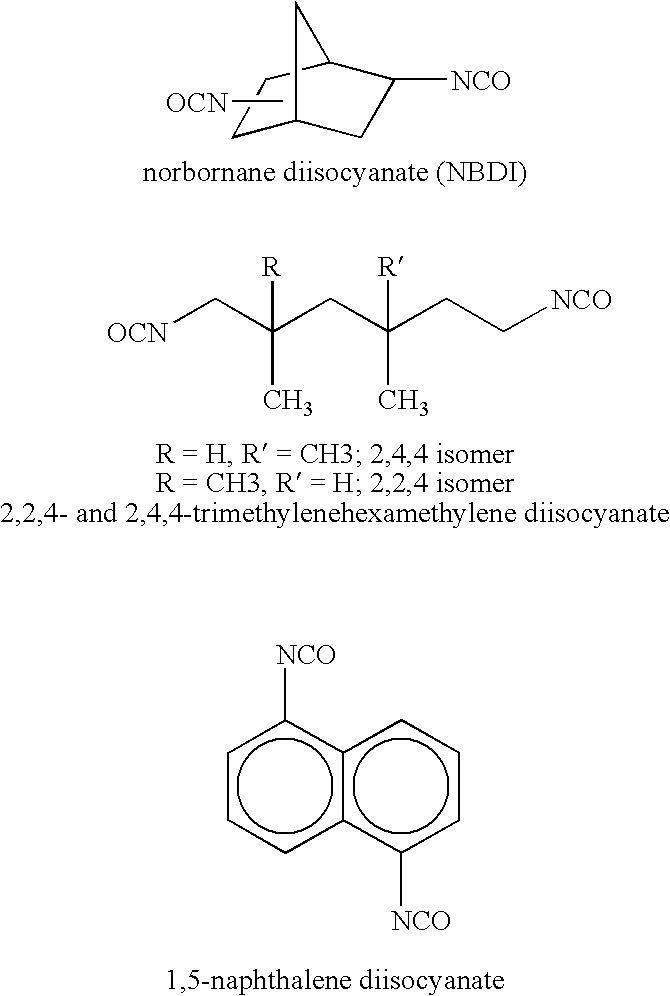Urethane (meth)acrylate resin with acrylic backbone and ink compositions containing the same
- Summary
- Abstract
- Description
- Claims
- Application Information
AI Technical Summary
Benefits of technology
Problems solved by technology
Method used
Image
Examples
example 1
2,480.2 g of Actflow UT-1001 (Soken Chemical & Engineering, Co., LTD), an acrylic polyol based primarily on 2-ethyl hexyl acrylate, was mixed with 717.3 g of OTA-480 (Propoxylated Glycerol Triacrylate, Surface Specialties UCB), 3.6 g of Triphenyl Stibine (Atofina Chemicals), and 5.4 g of Dabco T-12 (Air Products and Chemicals), dibutyltin dilaurate, at room temperature. Then, 350.0 g of Desmodur I (Bayer), isophoronediisocyanate, was charged to 5 L a round-bottomed flask, and the polyol mixture was added, with agitation over 30 minutes. The temperature increased from 27 to 66° C. The contents of the flask were held at 66° C. for 30 minutes, then the temperature was increased to 88° C., and the contents were held at 88° C. for 1 hour. 55.7 g of 2-hydroxy ethyl acrylate (Dow), mixed with 0.7 g of hydroquinone (Eastman Chemicals) was added over 10 minutes. The flask contents were held at 88° C. for another hour, then an additional 0.7 g of hydroquinone was added with stirring. After s...
example 2
514 g of Actflow UT-1001 (Soken), was mixed with 1.31 g of Dabco T-12 (Air Products and Chemicals), and heated to 93 C. 158.5 Desmodur I (Bayer) was charged to a 3 L round-bottomed flask, and the polyol mixture added over 30 minutes. The temperature increased from 20 to 60 C. The content of the flask were held at 70 C for 2 hrs and 15 minutes, then 71 g of 2-hydroxy ethyl acrylate (Dow), mixed with 0.18 g para-methoxy phenol (Aldrich) was added over 20 minutes. The flask contents were heated from 70 to 88 C. After an additional 85 minutes, another 4 g of 2-hydroxy ethyl acrylate was added. After heating an additional 30 minutes, the flask was covered and allowed to cool to room temperature. After 13 hours, it was re-heated to 93 C, and held at 85 to 93 C for 2 hours, after which an additional 0.18 g of para-methoxy phenol was added, with stirring. After stirring an additional 5 to 20 minutes, the product poured from the flask. The resulting product was a clear, water-white viscous ...
example 3
541 g of Actflow UT-1001 (Soken), was mixed with 0.97 g of Dabco T-12 (Air Products and Chemicals), and heated to 93 C. 84 g of Desmodur I (Bayer) was charged to a 3 L round-bottomed flask, and the polyol mixture added over 85 minutes. During this time, the temperature increased from 20 to 70 C. The content of the flask were held at 70-90 C for 90 minutes, then 19.7 g of 2-hydroxy ethyl acrylate (Dow) and 0.13 g para-methoxy phenol (Aldrich) were added. The flask contents were held at 82-88 C. After an additional 2½ hours, an additional 0.13 g of para-methoxy phenol was added, with stirring. After stirring an additional 5 to 20 minutes, the product poured from the flask. The resulting product was a clear, water-white viscous liquid.
PUM
| Property | Measurement | Unit |
|---|---|---|
| Percent by mass | aaaaa | aaaaa |
| Percent by mass | aaaaa | aaaaa |
| Mass | aaaaa | aaaaa |
Abstract
Description
Claims
Application Information
 Login to View More
Login to View More - R&D
- Intellectual Property
- Life Sciences
- Materials
- Tech Scout
- Unparalleled Data Quality
- Higher Quality Content
- 60% Fewer Hallucinations
Browse by: Latest US Patents, China's latest patents, Technical Efficacy Thesaurus, Application Domain, Technology Topic, Popular Technical Reports.
© 2025 PatSnap. All rights reserved.Legal|Privacy policy|Modern Slavery Act Transparency Statement|Sitemap|About US| Contact US: help@patsnap.com



